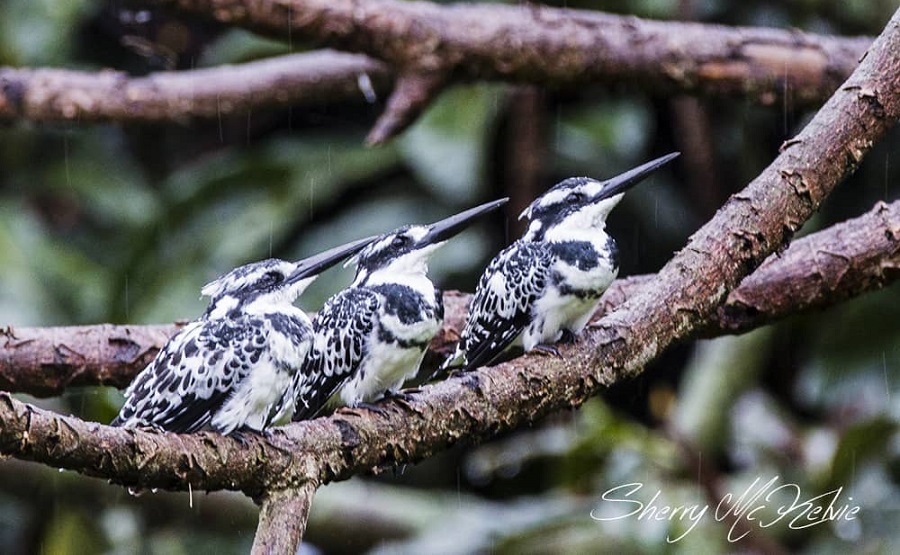
Bird watching: a 21st-century Safari! Kazinga Channel, Queen Elizabeth National Park
Have you noticed that the more Safaris you go on, the smaller the animal that catches your eye? It could be the butterflies or the reptiles; for some it’s even the insects! But, increasingly, with a pair of binoculars and a professional guide, it’s our feathered friends that are causing the excitement.
What is it about birds?
Few areas of the world can boast over 600 bird species; Uganda’s Queen Elizabeth National Park – one of the world’s most biodiverse Protected Areas – is one.
Queen Elizabeth, an area covering 1978 km², owes its rich biodiversity to its variety of habitats: Savannah, freshwater lakes, grasslands, swamps, Acacia and Euphorbia bush, salty crater lakes, moist tropical forest and more. It contains a Ramsar site (protected wetlands of international importance) and an IBA (Important Bird Area). Thus a trip to Queen Elizabeth is a trip to many different habitats with many different types of birds, some of them endemic – that’s to say unique to that particular place. The time of year will also affect which birdlife you will see, as many non-native species migrate over the country en route between Europe and summer nesting sites in South Africa.

Euphorbia cactus, Mweya Peninsula, Queen Elizabeth National Park Uganda. In the far distance is the DR Congo
Birdlife in Queen Elizabeth shows biodiversity at its best. Nature has adapted birds to fit every variety of habitat: it’s all about survival, and each bird’s characteristics have evolved to suit its particular ecological niche. Did you know… Queen Elizabeth National Park has more bird species than any other of Uganda’s National Parks?
Where is the best place to see birds in Queen Elizabeth?
A boat ride along the Kazinga Channel and the Mweya Peninsula joining Lakes George and Edward is an ideal starting point.
From the enormous Goliath Heron, a statuesque 1 metre high, to the tiny jewel-like Malachite Kingfisher, Queen Elizabeth’s bird life offers something for everyone to admire.
As our boat slowly meandered along the Kazinga Channel towards Lake Edward, our excellent Uganda Wildlife Authority guide Bernard listed the different bird species we passed.
Highlights included: Common Squacco Heron, Greenshank, Wood Sandpiper, Common Godwit, and a Water Thick-knee (a Wader with big eyes) feeding on the shore; and a lone African Spoonbill (its bill really does look like a spoon!) behind them.
We admired the gorgeous monochrome Sacred Ibis with its elegant curved beak; handsome Egyptian Geese and a Eurasian Marsh Harrier and an African Fish Eagle looking down at us from a tall tree.
Flocks of loud, luminous Glossy Starlings flitted from bush to bush; vibrant Madagascar Bee-eaters and beautiful little, water-loving Blue Breasted Bee-eaters hovered in and around the burrows they’ve excavated out of the earth banks.
Pied (black and white) Kingfishers are a common sight, hovering in the air before plunging beak first into the water – an incredible 1,900 were recorded one July – and Yellow-billed Oxpeckers perch on the backs of Buffalo, removing their ticks (an arrangement that suits both parties well!)
Uganda’s famous scrawny old men of the bird world, the famous Marabou Stork, are residents of the Kazinga Channel too. These ugly birds are surprisingly elegant – just see them glide atop the thermals.

Marabou Stork outside UWA’s Tembo Canteen on Mweya Peninsula, Queen Elizabeth National Park, Kazinga Channel in the background
As we approached the lake, flocks of thousands of birds flew off in a circle above our heads alighting again on the sandbars at the water’s edge : White-winged Terns, Great and Long-tailed Cormorants, African Skimmers (Queen Elizabeth is the easiest place to see these large birds), Great White and Pink-backed Pelicans, the psychedelic Saddle billed Stork, and Great White Egrets.
What a spectacular sight!
Back on the Mweya Peninsula, look out for the enormous nest of the “King birds”, the Hammerkop, the biggest nest of its type (also home to the occasional snake!) and a favourite vantage point for Eagle Owls. With more time, a visit to Munyanyange Crater Lake north of Katwe is an absolute must – over 2,000 Lesser Flamingos were counted there one February.
As for the famous yet elusive Shoebill? Well, you’ll just have to ask your guide nicely if he’ll venture into the dense papyrus beds of Lake Kikorongo to spot one!

This is my dad! Looking for birds but actually spotting buffalo and hippo on Lake Nyamunuka crater lake, north of Mweya, Queen Elizabeth National Park
Is bird watching in Queen Elizabeth on your itinerary?
It certainly should be!
Birding is just one of the many different wildlife experiences Queen Elizabeth has to offer.
The Uganda Wildlife Authority’s mongooses experience is another fascinating day out.
There are some very cool local community tourism projects, too, promoted by UCOTA.
Visiting Deo the farmer and the elephant trench in Ishasha, excavated thanks to the Uganda Conservation Foundation, is another brilliant tourism experience.
How about a morning game drive to see the lions?

Sometimes you don’t need a telephoto lens! This gorgeous pair just strolled right past our car… early morning lions in Queen Elizabeth National Park,Uganda
Have you been bird watching in Queen Elizabeth National Park?
Where is your favourite place to watch birds in Uganda?
Let me know in the comments 🙂






























Bird watchers should flock to this area! In fact there is something for everyone as your article describes beautifully.
Great job again Cha. Marvellous pictures too! You really inspire the reader to jump on the next plane! PAxx
So when are you coming?
🙂